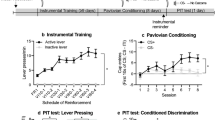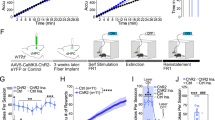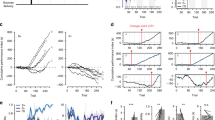Abstract
Reward-related incentive learning involves the acquisition by neutral stimuli of an enhanced ability to elicit approach and other responses. Previous studies have shown that both dopamine (DA) and glutamate (Glu) play critical roles in this type of learning. Signaling molecules are intracellular messengers that participate in the influence of transmitter-receptor events on intracellular function including transcription in the nucleus. In recent years studies have begun to implicate signaling molecules in incentive learning. Thus, inhibition of cyclic adenosine monophosphate-dependent protein kinase (PKA) in the nucleus accumbens (NAc), that is activated by DA acting at D1-like receptors, blocks the acquisition of conditioned approach responses, lever pressing for food, conditioned place preference (CPP) based on NAc injections of amphetamine or cocaine, and conditioned activity based on NAc injections of amphetamine. Similar effects have been observed with PKA inhibition in the basolateral amygdala or medial prefrontal cortex. If animals were trained prior to testing with PKA inhibitors in NAc, no effect was seen suggesting that PKAis more important for acquisition than expression of incentive learning.Inhibition of calcium-dependent protein kinase or mitogen-activated protein kinases in NAc similarly has been shown to block the acquisition of incentive learning. Results support a model of DA-Glu synaptic interactions that form the basis of incentive learning.
Similar content being viewed by others
References
Abrams TW, KA Karl and ER Kandel (1991) Biochemical studies of stimulus convergence during classical conditioning in Aplysia, dual regulation of adenylate cyclase by Ca2+/calmodulin and transmitter.J. Neurosci. 11, 2655–2665.
Adams JP and JD Sweatt (2002) Molecular psychology, roles for the ERK MAP kinase cascade in memory.Annu. Rev. Pharmacol. Toxicol. 42, 135–163.
Aujla H and RJ Beninger (2003) Intra-accumbens protein kinase C inhibitor NPC 15437 blocks amphetamine-produced conditioned place preference in rats.Behav. Brain Res. 147, 41–48.
Baldwin AE, K Sadeghian and AE Kelley (2002a) Appetitive instrumental learning requires coincident activation of NMDA and dopamine D1 receptors within the medial prefrontal cortex.J. Neurosci. 22, 1063–1071.
Baldwin AE, K Sadeghian, MR Holahan and AE Kelley (2002b) Appetitive instrumental learing is impaired by inhibition of cAMP-dependent protein kinase within the nucleus accumbens.Neurobiol. Learn. Mem. 77, 44–62.
Beninger RJ (1983) The role of dopamine in locomotor activity and learning.Brain Res. Rev. 6, 173–196.
Beninger RJ (1993) Role of D1 and D2 receptors in learning, InD1,D2 Dopamine Receptor Interactions, Neuroscience and Pharmacology (Waddington J, Ed.) (Academic Press: London), pp 115–157.
Beninger RJ and TV Gerdjikov (2004) Dopamine-glutamate interactions in reward-related incentive learning, InDopamine and Glutamate in Psychiatric Disorders (Schmidt WJ and MEA Reith, Eds.) (Humana Press Inc.: Totowa, NJ) in press.
Beninger RJ and R Miller (1998) Dopamine D1-like receptors and reward-related incentive learning.Neurosci. Biobehav. Rev. 22, 335–345.
Beninger RJ, M Cheng, BL Hahn, DC Hoffman, EJ Mazurski, MA Morency, P Ramm and RJ Stewart (1987) Effects of extinction, pimozide, SCH 23390, and metoclopramide on food-reinforced operant responding.Psychopharmacology (Berl.) 92, 343–349.
Beninger RJ, PL Nakonechny and I Savina (2003a) cAMP-dependent protein kinase and reward-related learning, intra-accumbens Rp-cAMPS blocks amphetamine-produced place conditioning in rats.Psychopharmacology (Berl.) 170, 23–32.
Beninger RJ, J Wiesenthal and AC Giles (2003b) Conditioned locomotion based on nucleus accumbens amphetamine, enhancement by PKA inhibitor Rp-cAMPS.Behav. Pharmacol. 14, Suppl. 1, S73.
Berridge KC and TE Robinson (1998) What is the role of dopamine in reward, hedonic impact, reward learning, or incentive salience?Brain Res. Rev. 28, 309–369.
Bindra D (1974) A motivational view of learning, performance and behavior modification.Psychol.Rev. 81, 199–213.
Carlezon WA Jr, J Thome, VG Olson, SB Lane-Ladd, ES Brodkin, N Hiroi, RS Duman, RL Neve and EJ Nestler (1998) Regulation of cocaine reward by CREB.Science 282, 2272–2275.
Carr GD and NM White (1983) Conditioned place preference from intra-accumbens but not intra-caudate amphetamine injections.Life Sci. 33, 2551–2557.
Carr GD and NM White (1986) Anatomical disassociation of amphetamine’s rewarding and aversive effects, an intracranial microinjection study.Psychopharmacology (Berl.) 89, 340–346.
Centonze D, B Picconi, P Gubellini, G Bernardi and P Calabresi (2001) Dopaminergic control of synaptic plasticity in the dorsal striatum.Eur. J. Neurosci. 13, 1071–1077.
Cepeda C and MS Levine (1998) Dopamine andN-methyl-D-aspar-tate receptor interactions in the neostriatum.Dev. Neurosci. 20, 1–18.
Cervo L and R Samanin (1995) Effects of dopaminergic and gluta-matergic receptor antagonists on the acquisition of cocaine conditioned place preference.Brain Res. 673, 242–250.
Cervo L, S Mukherjee, A Bertaglia and R Samanin (1997) Protein kinases A and C are involved in the mechanisms underlying consolidation of cocaine place conditioning.Brain Res. 775, 30–36.
Choe ES, KT Chung, L Mao and JQ Wang (2002) Amphetamine increases phosphorylation of extracellular signal-regulated kinase and transcription factors in the rat striatum via group I metabotropic glutamate receptors.Neuropsychopharmacology 27, 565–575.
Curtis J and S Finkbeiner (1999) Sending signals from the synapse to the nucleus, possible roles for CaMK, Ras/ERK, and SAPK pathways in the regulation of synaptic plasticity and neuronal growth.J. Neurosci. Res. 58, 88–95.
Das S, M Grunert, L Williams and SR Vincent (1997) NMDA and D1 receptors regulate the phosphorylation of CREB and the induction of c-fos in striatal neurons in primary culture.Synapse 25, 227–233.
Fiala A, U Muller and R Menzel (1999) Reversible downregulation of protein kinase A during olfactory learning using antisense technique impairs long-term memory formation in the honeybee,Apis mellifera.J. Neurosci. 19, 10125–10134.
Gerdjikov TV, GM Ross and RJ Beninger (2004) Place preference induced by nucleus accumbens amphetamine is impaired by antagonists of ERK or p38 MAP kinases in rats.Behav. Neurosci. in press
Gnegy ME (1982) Relationship of calmodulin and dopaminergic activity in the striatum.Fed. Proc. 41, 2273–2277.
Hitchcott PK and GD Phillips (1998) Double dissociation of the behavioural effects ofR(+) 7-OH-DPAT infusions in the central and basolateral amygdala nuclei upon Pavlovian and instrumental conditioned appetitive behaviours.Psychopharmacology (Berl.) 140, 458–469.
Hyman SE and RC Malenka (2001) Addiction and the brain, the neurobiology of compulsion and its persistence.Nat. Rev. Neurosci. 2, 695–703.
Izquierdo I and JH Medina (1997) Memory formation, the sequence of biochemical events in the hippocampus and its connection to activity in other brain structures.Neurobiol. Learn. Mem. 68, 285–316.
Izquierdo I, JH Medina, MRM Vianna, LA Izquierdo and DM Barros (1999) Separate mechanisms for short- and long-term memory.Behav. Brain Res. 103, 1–11.
Jentsch JD, P Olausson, EJ Nestler and JR Taylor (2002) Stimulation of protein kinase A activity in the rat amygdala enhances reward-related learning.Biol. Psychiatry 52, 111–118.
Kandel E (2001) The molecular biology of memory storage, a dialogue between genes and synapses.Science 294, 1030–1038.
Kelley AE (1999) Neural integrative activities of nucleus accum-bens subregions in relation to learning and motivation.Psychobiol.27, 198–213.
Kelley AE and KC Berridge (2002) The neuroscience of natural rewards, relevance to addictive drugs.[comment].J. Neurosci. 22, 3306–3311.
Kelley AE and MR Holahan (1997) Enhanced reward-related responding following cholera toxin infusion into the nucleus accumbens.Synapse 26, 46–54.
Kita H and ST Kitai (1988) Glutamate decarboxylase immunoreac-tive neurons in rat neostriatum, their morphological types and populations.Brain Res. 447, 346–352.
Konradi C, JC Leveque and SE Hyman (1996) Amphetamine and dopamine-induced immediate early gene expression in striatal neurons depends on postsynaptic NMDA receptors and calcium.J. Neurosci. 16, 4231–4239.
Lisman JE and AM Zhabotinsky (2001) A model of synaptic memory, a CaMKII/PP1 switch that potentiates transmission by organizing an AMPA receptor anchoring assembly.Neuron 31, 191–201.
Lisman J, H Schulman and H Cline (2002) The molecular basis of CaMKII function in synaptic and behavioural memory.Nat. Rev. Neurosci. 3, 175–190.
Mazzucchelli C, C Vantaggiato, A Ciamei, S Fasano, P Pakhotin, W Krezel, H Welzl, DP Wolfer, G Pages, O Valverde, A Marowsky, A Porrazzo, PC Orban, R Maldonado, MU Ehrengruber, V Cestari, HP Lipp, PF Chapman, J Pouyssegur and R Brambilla (2002) Knockout of ERK1 MAP kinase enhances synaptic plasticity in the striatum and facilitates striatal-mediated learning and memory.Neuron 34, 807–820.
Miller R (1981)Meaning and Purpose in the Intact Brain (Clarendon Press: Oxford, UK).
Miller R, JR Wickens and RJ Beninger (1990) Dopamine D-1 and D-2 receptors in relation to reward and performance, A case for the D-1 receptor as a primary site of therapeutic action of neu-roleptic drugs.Prog. Neurobiol. 34, 143–183.
Narita M, T Aoki, S Ozaki, Y Yajima and T Suzuki (2001) Involvement of protein kinase Cg isoform in morphine-induced reinforcing effects.Neuroscience 103, 309–314.
Nicola SM, DJ Surmeier and RC Malenka (2000) Dopaminergic modulation of neuronal excitability in the striatum and nucleus accumbens.Annu. Rev. Neurosci. 23, 185–215.
Pliakas AM, RR Carlson, RL Neve, C Konradi, EJ Nestler and WA Carlezon Jr (2001) Altered responsiveness to cocaine and increased immobility in the forced swim test associated with elevated cAMP response element-binding protein expression in nucleus accumbens.J. Neurosci. 21, 7397–7403.
Rankin CH (2002) From gene to identified neuron to behaviour inCaenorhabditis elegans.Nat. Rev. Genetics 3, 622–630.
Reynolds JNJ and JR Wickens (2000) Substantia nigra dopamine regulates synaptic plasticity and membrane potential fluctuations in the rat neostratum,in vivo.Neuroscience 99, 199–204.
Reynolds JN, BI Hyland and JR Wickens (2001) A cellular mechanism of reward-related learning.Nature 413, 67–70.
Rose SPR (2000) God’s organism? The chick as a model system for memory studies.Learn. Mem. 7, 1–17.
Self DW, RZ Terwilliger, EJ Nestler and L Stein (1994) Inactivation of Gi and Go proteins in nucleus accumbens reduces both cocaine and heroin reinforcement.J. Neurosci. 14, 6239–6247.
Self DW, LM Genova, BT Hope, WJ Barnhart, JJ Spencer and EJ Nestler (1998) Involvement of cAMP-dependent protein kinase in the nucleus accumbens in cocaine self-administration and relapse of cocaine-seeking behavior.J. Neurosci. 18, 1848–1859.
Smith AD and JP Bolam (1990) The neural network of the basal ganglia as revealed by the study of synaptic connections of identified neurons.Trends Neurosci. 13, 259–265.
Stemmelin J, C Mathis and A Ungerer (1999) GF 109203X, a selective inhibitor of protein kinase C, impairs retention performance in an operant task.Neuroreport 10, 2805–2809.
Sutton MA and RJ Beninger (1999) Psychopharmacology of conditioned reward, evidence for a rewarding signal at D1-like dopamine receptors.Psychopharmacology (Berl.) 144, 95–110.
Sutton MA, K McGibney and RJ Beninger (2000) Conditioned locomotion in rats following amphetamine infusion into the nucleus accumbens, blockade by coincident inhibition of protein kinase A.Behav. Pharmacol. 11, 365–376.
Tan SE (2002) Impairing the amphetamine conditioning in rats through the inhibition of hippocampal calcium/calmodulin-dependent protein kinase II activity.Neuropharmacology 42, 540–547.
Thomas KL and BJ Everitt (2001) Limbic-cortical-ventral striatal activation during retrieval of a discrete cocaine-associated stimulus, a cellular imaging study with g protein kinase C expression.J. Neurosci. 21, 2526–2535.
Tzschentke TM (1998) Measuring reward with the conditioned place preference paradigm, a comprehensive review of drug effects, recent progress and new issues.Prog. Neurobiol. 56, 613–672.
Valjent E, JC Corvol, C Pages, MJ Besson, R Maldonado and J Caboche (2000) Involvement of the extracellular signal-regulated kinase cascade for cocaine-rewarding properties.J. Neurosci. 20, 8701–8709.
Vincent SL, M Sebben, A Dumuis and J Bockaert (1998) Neurotransmitter regulation of MAP kinase signaling in striatal neurons in primary culture.Synapse 29, 29–36.
Waddell S and WG Quinn (2001) Flies, genes, and learning.Annu. Rev. Neurosci. 24, 1283–1309.
Wickens J (1988) Electrically coupled but chemically isolated synapses, dendritic spines and calcium in a rule for synaptic modification.Prog. Neurobiol. 31, 507–528.
Wickens J (1990) Striatal dopamine in motor activation and reward-mediated learning, steps towards a unifying model.J. Neural Transm. 80, 9–31.
Wickens JR (1993)A Theory of the Striatum (Pergamon: Tarrytown, NY).
Wickens J and R Kötter (1995) Cellular models of reinforcement, InModels of Information Processing in the Basal Ganglia (Houk JC, J Davis and DG Beiser, Eds.) (MIT Press: Cambridge, MA) pp 187–214.
Wise RA (1989) Opiate reward: sites and substrates.Neurosci. Biobehav. Rev. 13, 129–133.
Xia ZG, EJ Choi, DR Storm and C Blazynski (1995) Do the calmodulin-stimulated adenylyl cyclases play a role in neuro-plasticity?Behav. Brain Sci. 18, 429–440.
Yovell Y, ER Kandel, Y Dudai and TW Abrams (1992) A quantitative study of the [Ca2+]-calmodulin sensitivity of adenylyl cyclase in Aplysia, Drosophila, ansd rat.J. Neurochem. 59, 1736–1744.
Zachariou V, M Benoit-Marand, PB Allen, P Ingrassia, AA Fienberg, F Gonon, P Greengard and MR Picciotto (2002) Reduction of cocaine place preference in mice lacking the protein phosphatase 1 inhibitors DARPP 32 or Inhibitor 1.Biol. Psychiatry 51, 612–620.
Author information
Authors and Affiliations
Corresponding author
Rights and permissions
About this article
Cite this article
Beninger, R.J., Gerdjikov, T.V. The role of signaling molecules in reward-related incentive learning. neurotox res 6, 91–103 (2004). https://doi.org/10.1007/BF03033301
Received:
Revised:
Issue Date:
DOI: https://doi.org/10.1007/BF03033301




